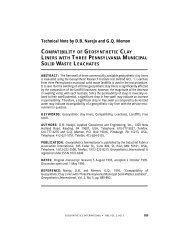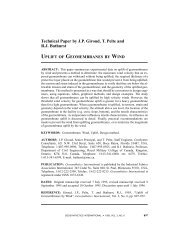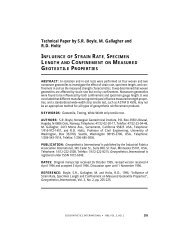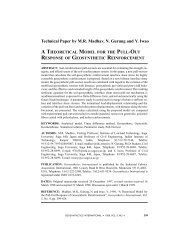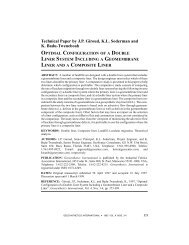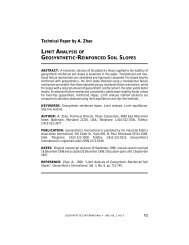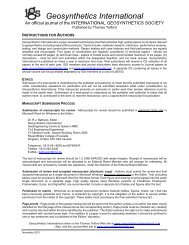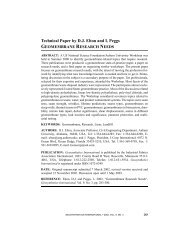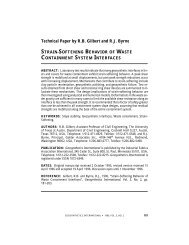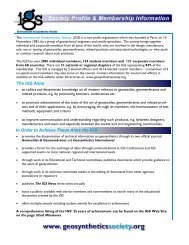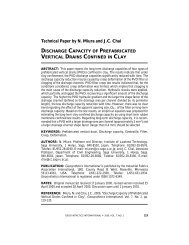soil-geosynthetic interaction - IGS - International Geosynthetics Society
soil-geosynthetic interaction - IGS - International Geosynthetics Society
soil-geosynthetic interaction - IGS - International Geosynthetics Society
Create successful ePaper yourself
Turn your PDF publications into a flip-book with our unique Google optimized e-Paper software.
Technical Paper by M.J. Lopes and M.L. Lopes<br />
SOIL-GEOSYNTHETIC INTERACTION – INFLUENCE<br />
OF SOIL PARTICLE SIZE AND GEOSYNTHETIC<br />
STRUCTURE<br />
ABSTRACT: This paper reports the results of pullout tests on five different <strong>geosynthetic</strong>s<br />
embedded in two different granular <strong>soil</strong>s. Soil and <strong>geosynthetic</strong> properties are<br />
described and <strong>soil</strong>-<strong>geosynthetic</strong> <strong>interaction</strong> behaviour is studied. Based on the results<br />
of pullout tests, the influence of <strong>soil</strong> particle size, <strong>geosynthetic</strong> structure, and the role<br />
of geogrid bearing members are discussed. The main conclusion is that the influence<br />
of <strong>soil</strong> particle size on <strong>soil</strong>-<strong>geosynthetic</strong> <strong>interaction</strong> is important, but its significance depends<br />
on several factors. With geogrids, the relative sizes of <strong>soil</strong> particles and geogrid<br />
apertures, and the thickness of the geogrid bearing members, determine <strong>soil</strong>-geogrid<br />
interface shear resistance. A marked increase in <strong>soil</strong>-geogrid interface shear resistance<br />
was observed when the <strong>soil</strong> contained a significant percentage of particles with sizes<br />
slightly greater than the thickness of the geogrid bearing members, but smaller than the<br />
geogrid apertures. Tests, on geogrids in which the bearing members had been cut, show<br />
a significant decrease in <strong>soil</strong>-geogrid interface shear resistance. The influence of <strong>soil</strong><br />
particle size is less important for geotextiles and geocomposites. Although the structure<br />
of geotextiles and geocomposites has an effect on <strong>soil</strong>-reinforcement interface behaviour,<br />
mobilised pullout resistance is also affected by the axial tensile stiffness of geotextiles<br />
and geocomposites.<br />
KEYWORDS: Pullout test, Geogrid, Geotextile, Geocomposite, Interaction, Soil<br />
particle size, Geosynthetic structure, Bearing member.<br />
AUTHORS: M.J. Lopes, Ph.D. candidate, and M.L. Lopes, Assistant Professor,<br />
Department of Civil Engineering, Geotechnical Division, University of Porto, Rua dos<br />
Bragas 4099 Porto Codex, Portugal, Telephone: 351/2-2041945, Telefax:<br />
351/2-2003640, E-mail: lcosta@fe.up.pt.<br />
PUBLICATION: <strong>Geosynthetics</strong> <strong>International</strong> is published by the Industrial Fabrics<br />
Association <strong>International</strong>, 1801 County Road B West, Roseville, Minnesota<br />
55113-4061, USA, Telephone: 1/651-222-2508, Telefax: 1/651-631-9334.<br />
<strong>Geosynthetics</strong> <strong>International</strong> is registered under ISSN 1072-6349.<br />
DATES: Original manuscript received 5 January 1999, revised version received 3 June<br />
1999 and accepted 29 June 1999. Discussion open until 1 March 2000.<br />
REFERENCE: Lopes, M.J. and Lopes, M.L., 1999, “Soil-Geosynthetic Interaction<br />
- Influence of Soil Particle Size and Geosynthetic Structure”, <strong>Geosynthetics</strong><br />
<strong>International</strong>, Vol. 6, No. 4, pp. 261-282.<br />
GEOSYNTHETICS INTERNATIONAL S 1999, VOL. 6, NO. 4<br />
261
LOPES AND LOPES D Soil-Geosynthetic Interaction<br />
1 INTRODUCTION<br />
Pullout tests were used to characterize <strong>soil</strong>-<strong>geosynthetic</strong> reinforcement <strong>interaction</strong><br />
with relative <strong>soil</strong>-<strong>geosynthetic</strong> reinforcement movement, as the <strong>geosynthetic</strong> is subjected<br />
to pullout.<br />
The test program involved a study of the <strong>soil</strong>-<strong>geosynthetic</strong> <strong>interaction</strong> of two high<br />
density polyethylene uniaxial geogrids, a polypropylene biaxial geogrid, a polypropylene<br />
nonwoven spun-bonded geotextile, and a geocomposite comprising a polypropylene<br />
nonwoven spun-bonded geotextile reinforced in the machine direction with<br />
polyester yarns. Two different granular <strong>soil</strong>s were used for the pullout tests.<br />
2 TEST EQUIPMENT<br />
The pullout tests were performed using the apparatus shown in Figure 1, which is described<br />
in detail by Lopes and Ladeira (1996). The pullout box is 1.53 m long, 1.00 m<br />
wide, and 0.80 m deep. The pullout boxtop wall-<strong>soil</strong> friction wasreduced using a 25mmthick<br />
neoprene sheet. Tests were performed at a constant displacement rate of 2mm/minute.<br />
The pullout force, applied by a hydraulic system, was measured using a load cell<br />
placed in the clamping system (Figure 2) that transmits the force to the reinforcement.<br />
Vertical stress was applied, normal to the plane of the <strong>geosynthetic</strong> reinforcement,<br />
using a platen that was loaded by ten small hydraulic jacks (Figure 1). Tests were run<br />
at <strong>soil</strong> constant volume. The displacement along the <strong>geosynthetic</strong> was measured using<br />
inextensible wires with one end connected to the <strong>geosynthetic</strong> and the other end connected<br />
to linear potentiometers placed outside the pullout box (Figure 1b). The results<br />
were recorded by an automatic data acquisition system.<br />
3 MATERIALS<br />
3.1 Soils<br />
Two sands, with the particle size distributions shown in Figures 3 and 4, were used<br />
in the tests. Soil 1 minimum and maximum unit weight values range from 15.5 to 17.9<br />
kN/m 3 for <strong>soil</strong> particle diameter values that range from 0.0074 to 2.00 mm (Figure 3).<br />
Soil 2 minimum and maximum unit weight values range from 15.6 to 18.7 kN/m 3 for<br />
<strong>soil</strong> particle diameter values that range from 0.0074 to 9.54 mm (Figure 4). The physical<br />
properties of the two <strong>soil</strong>s are given in Table 1.<br />
The coefficient of uniformity, C U , coefficient of curvature, C C , and relative density, I D ,<br />
values of Soils and 1 and 2 are calculated using the following expressions, respectively:<br />
C U = D 60<br />
(1)<br />
C C = (D 30 ) 2<br />
D 10 D 60<br />
D 10<br />
(2)<br />
262 GEOSYNTHETICS INTERNATIONAL S 1999, VOL. 6, NO. 4
LOPES AND LOPES D Soil-Geosynthetic Interaction<br />
(a)<br />
(b)<br />
Figure 1.<br />
view.<br />
Pullout apparatus: (a) front view showing the hydraulic system; (b) lateral<br />
Table 1.<br />
Physical properties of the two types of <strong>soil</strong> used in the test program.<br />
Soils<br />
D min<br />
(mm)<br />
D 10<br />
(mm)<br />
D 30<br />
(mm)<br />
D 50<br />
(mm)<br />
D 60<br />
(mm)<br />
D max<br />
(mm)<br />
C U C C<br />
γ min<br />
(kN/m 3 )<br />
γ max<br />
(kN/m 3 )<br />
γ (ID = 55%)<br />
(kN/m 3 )<br />
φ*<br />
(_)<br />
Soil 1 0.074 0.26 0.32 0.43 0.5 2.00 1.92 0.79 15.0 17.9 16.45 35.7<br />
Soil 2 0.074 0.44 0.90 1.30 1.6 9.54 3.64 1.15 15.6 18.7 17.15 44.2<br />
Note:<br />
* Soil residual internal friction angle (at 38.0 kPa vertical pressure) in direct shear.<br />
GEOSYNTHETICS INTERNATIONAL S 1999, VOL. 6, NO. 4<br />
263
LOPES AND LOPES D Soil-Geosynthetic Interaction<br />
Figure 2.<br />
Geosynthetic clamping system used in the pullout apparatus.<br />
I D =<br />
γ max<br />
γ (ID =55%)<br />
γ (ID =55%) − γ min<br />
γ max − γ min<br />
× 100%<br />
(3)<br />
where D 10 , D 30 ,andD 60 are the <strong>soil</strong> particle diameters corresponding to 10, 30, and<br />
60% by weight of finer particles passed during sieving (Figures 3 and 4), γ min and γ max<br />
are the minimum and maximum <strong>soil</strong> unit weight values, and γ (ID = 55%) is the unit weight<br />
for <strong>soil</strong> with a relative density of I D = 55%.<br />
Both <strong>soil</strong>s were compacted to a relative density, I D = 55%. For I D = 55%, γ = 16.45<br />
and 17.15 kN/m 3 for Soils 1 and 2, respectively.<br />
3.2 <strong>Geosynthetics</strong><br />
The following <strong>geosynthetic</strong>s were used in the pullout test program:<br />
1. two high density polyethylene uniaxial geogrids (Geogrids GG1 and GG2);<br />
2. a polypropylene biaxial geogrid (Geogrid GG3);<br />
3. a polypropylene nonwoven spun-bonded geotextile (Geotextile GT1); and<br />
4. a geocomposite comprising a polypropylene nonwoven spun-bonded geotextile reinforced<br />
in the machine direction with polyester yarn (Geocomposite GT2).<br />
The physical properties of Geogrids GG1, GG2, and GG3, Geotextile GT1, and Geocomposite<br />
GT2 are presented in Table 2 and Figures 5 and 6, Table 3 and Figure 7, and<br />
Tables 4 and 5, respectively.<br />
264 GEOSYNTHETICS INTERNATIONAL S 1999, VOL. 6, NO. 4
LOPES AND LOPES D Soil-Geosynthetic Interaction<br />
100<br />
Cumulative fraction passing (%)<br />
90<br />
80<br />
70<br />
60<br />
50<br />
40<br />
30<br />
20<br />
10<br />
0<br />
0.05 0.1 0.5 1 5 10<br />
Particle size (mm)<br />
Figure 3.<br />
Soil 1 particle size distribution.<br />
100<br />
90<br />
Cumulative fraction passing (%)<br />
80<br />
70<br />
60<br />
50<br />
40<br />
30<br />
20<br />
10<br />
0<br />
0.05 0.1 0.5 1 5 10<br />
Particle size (mm)<br />
Figure 4. Soil 2 particle size distribution.<br />
GEOSYNTHETICS INTERNATIONAL S 1999, VOL. 6, NO. 4<br />
265
LOPES AND LOPES D Soil-Geosynthetic Interaction<br />
t R<br />
t B<br />
a L<br />
a T<br />
b R<br />
b B<br />
18<br />
Figure 5.<br />
Geometry of uniaxial Geogrids GG1 and GG2.<br />
90<br />
80<br />
Quality control limit 80 kN/m<br />
70<br />
Load (kN/m)<br />
60<br />
50<br />
40<br />
30<br />
20<br />
10<br />
0 4 8 12 16<br />
Strain (%)<br />
Figure 6.<br />
Tensile behaviour of uniaxial Geogrid GG2.<br />
266 GEOSYNTHETICS INTERNATIONAL S 1999, VOL. 6, NO. 4
LOPES AND LOPES D Soil-Geosynthetic Interaction<br />
Table 2.<br />
Physical properties of uniaxial Geogrids GG1 and GG2.<br />
Geogrid<br />
a L<br />
(mm)<br />
a T<br />
(mm)<br />
b B<br />
(mm)<br />
b R<br />
(mm)<br />
t B<br />
(mm)<br />
t R<br />
(mm)<br />
Tensile strength<br />
(kN/m)<br />
Peak strain<br />
(%)<br />
GG1 160.0 16.0 16.0 6.0<br />
GG2 235.0 16.0 16.0 6.0<br />
2.7 max.<br />
2.5 min.<br />
3.7 max.<br />
3.4 min.<br />
0.9 55.0 11.5<br />
1.3 80.0 11.5<br />
Table 3.<br />
Physical properties of biaxial Geogrid GG3.<br />
Geogrid<br />
a L<br />
(mm)<br />
a T<br />
(mm)<br />
b LR<br />
(mm)<br />
b TR<br />
(mm)<br />
t J<br />
(mm)<br />
t LR<br />
(mm)<br />
t TR<br />
(mm)<br />
MD<br />
(kN/m)<br />
Tensile strength<br />
XMD<br />
(kN/m)<br />
Peak<br />
strain<br />
(%)<br />
GG3 33.0 33.0 2.2 2.5 5.8 2.2 1.4 40.0 40.0 11.5<br />
Note:<br />
MD = machine direction, XMD = cross-machine direction.<br />
Table 4.<br />
Physical properties of nonwoven Geotextile GT1.<br />
Geotextile<br />
Thickness<br />
Mass per unit area<br />
Tensile strength<br />
Peak strain, MD/XMD<br />
(mm)<br />
(g/m 2 )<br />
(kN/m)<br />
(%)<br />
GT1 6.0 800.0 50.0 65.0 / 57.0<br />
Note:<br />
MD = machine direction, XMD = cross-machine direction.<br />
t J<br />
t TR<br />
t LR<br />
a L<br />
b LR<br />
a T<br />
W<br />
b TR<br />
Figure 7.<br />
Geometry of biaxial Geogrid GG3.<br />
GEOSYNTHETICS INTERNATIONAL S 1999, VOL. 6, NO. 4<br />
267
LOPES AND LOPES D Soil-Geosynthetic Interaction<br />
Table 5.<br />
Physical properties of Geocomposite GT2.<br />
Geocomposite<br />
Thickness<br />
(mm)<br />
Mass per<br />
unit area<br />
(g/m 2 )<br />
Tensile strength<br />
Peak strain<br />
MD<br />
XMD<br />
MD<br />
XMD<br />
(kN/m) (kN/m) (%) (%)<br />
GT2 2.5 600.0 95.0 13.0 12.0 75.0<br />
Note:<br />
MD = machine direction, XMD = cross-machine direction.<br />
The <strong>geosynthetic</strong>s can be grouped according to their maximum tensile strength values:<br />
GG1, GG3, and GT1 have maximum tensile strength values ranging from 40 to<br />
55 kN/m; and GG2 and GT2 have maximum tensile strength values ranging from 80<br />
to 95 kN/m.<br />
4 TEST METHOD<br />
The <strong>soil</strong> was poured into the pullout box from a constant height of 0.50 m and placed<br />
in 0.15 m thick layers. Each layer was levelled and compacted to the required unit<br />
weight using an electric vibratory hammer. The <strong>soil</strong> unit weight was controlled with a<br />
nuclear densimeter. When the <strong>soil</strong> level reached the pullout slot at the front of the box<br />
(0.3 m), the reinforcement was laid on the surface of the compacted <strong>soil</strong> and fixed to<br />
the clamps outside the box.<br />
The inextensible wires, used to measure the displacement along the reinforcement,<br />
were then placed and connected to the linear potentiometers at the back and front of the<br />
box. Five potentiometers were used in the tests.<br />
Finally, two 0.15 m thick <strong>soil</strong> layers were placed, levelled, and compacted, resulting<br />
in a total <strong>soil</strong> thickness of 0.60 m with the <strong>geosynthetic</strong> reinforcement at the middle.<br />
The <strong>geosynthetic</strong> specimens were 0.96 m long and 0.33 m wide. The normal stress applied<br />
at the reinforcement height (i.e. at 0.3 m) was 38.0 kPa, and a displacement rate<br />
of 2 mm/minute was used. Although 13 tests are reported in Table 6, each one was repeated<br />
twice and, thus, a total of 39 tests was carried out.<br />
5 ANALYSIS OF TEST RESULTS<br />
5.1 Introduction<br />
Each test was repeated twice to determine a mean value and to ensure repeatability<br />
of the test results. A high degree of reproducibility was achieved as indicated in Figure<br />
8, which shows the variation of the measured pullout force with the geogrid front displacement<br />
for the three tests conducted using Geogrid GG2 specimens under the same<br />
conditions. For the three tests, the greatest variation of the maximum mobilised pullout<br />
force was 7% (2% for the other two tests). The test results should be presented in terms<br />
of the mean maximum pullout force value and the standard deviation.<br />
268 GEOSYNTHETICS INTERNATIONAL S 1999, VOL. 6, NO. 4
LOPES AND LOPES D Soil-Geosynthetic Interaction<br />
Table 6.<br />
Summary of the pullout test program.<br />
Test Soil Geosynthetic<br />
T1<br />
GG1<br />
T2<br />
GG2<br />
T3 Soil 1 GG3<br />
T4<br />
GT1<br />
T5<br />
GT2<br />
T6<br />
GG1<br />
T7<br />
GG2<br />
T8<br />
GG3<br />
T9 Soil 2 GT1<br />
T10<br />
GT2<br />
T11 GG1 * WBM<br />
T12 GG2 * WBM<br />
T13 GG3 * WBM<br />
Note:<br />
* Tests performed with the geogrid bearing members cut between ribs in the direction of pullout.<br />
40<br />
35<br />
Pullout force (kN/m)<br />
30<br />
25<br />
20<br />
15<br />
10<br />
5<br />
0<br />
0 20 40 60 80 100 120<br />
Front displacement (mm)<br />
Figure 8.<br />
Pullout test results for three tests using uniaxial Geogrid GG2.<br />
GEOSYNTHETICS INTERNATIONAL S 1999, VOL. 6, NO. 4<br />
269
LOPES AND LOPES D Soil-Geosynthetic Interaction<br />
The data collected from the pullout tests includes the variation of the mobilised pullout<br />
force with front displacement (i.e. reinforcement elongation, Figure 8), the total displacement<br />
along the reinforcement, and the displacement from integrated strains along<br />
the reinforcement. Typically, the latter two types of displacement are measured the moment<br />
when the maximum pullout force is mobilised.<br />
The displacement from integrated strains along the reinforcement provides information<br />
regarding the stress transfer from the <strong>soil</strong> to the reinforcement and, therefore, the<br />
mobilisation of shear stresses on the <strong>soil</strong>-reinforcement interface. Finally, it is possible<br />
to define the bond coefficient, f, of the <strong>soil</strong>-reinforcement interfaces, as follows:<br />
f =<br />
τ<br />
σ n tan φ<br />
(4)<br />
where: τ and σ n = shear and normal stresses at the <strong>soil</strong>-reinforcement interface, respectively;<br />
and φ = internal friction angle of the <strong>soil</strong>.<br />
The mobilisation of the pullout force with the reinforcement front displacement is<br />
presented for every case considered. For clarity, the total displacement and the displacement<br />
from integrated strains at the instant when the maximum pullout force is mobilised<br />
are presented for only one of the <strong>geosynthetic</strong>s tested in the current study.<br />
5.2 Influence of Soil Particle Size<br />
Soil particle size is one of the factors affecting the <strong>soil</strong>-reinforcement interface behaviour<br />
in reinforced <strong>soil</strong> structures and has been studied by Jewell et al. (1984), Palmeira<br />
and Milligan (1989), Jewell (1990, 1996), Boyle and Holtz (1994), Chen and Chen<br />
(1994), and Forsman and Slunga (1994).<br />
Because two different <strong>soil</strong>s are considered in the current study, parameters, such as<br />
<strong>soil</strong> unit weight, are distinct and affect the <strong>soil</strong>-reinforcement interface behaviour. To<br />
minimize this problem, the two <strong>soil</strong>s were placed in the pullout box with the same relative<br />
density by adjusting the compaction process.<br />
Geogrid GG1 exhibits different behaviour when embedded in either Soil 1 or Soil<br />
2, Figure 9 (Tests T1 and T6 in Table 6). For Geogrid GG1 in Soil 1, the maximum pullout<br />
force is 40.4 kN/m, mobilised at a front displacement of 106.3 mm. For Geogrid<br />
GG1 in Soil 2, the maximum pullout force is 38.1kN/m, mobilised at a front displacement<br />
of 91.0 mm. It is noted that for Soil 2, the geogrid reinforcement fails by tensile<br />
rupture and not by pullout, which simply means that the pullout resistance is higher than<br />
the <strong>geosynthetic</strong> tensile strength.<br />
This behaviour can be explained by the different relationship between the <strong>soil</strong> particle<br />
size and the geogrid aperture size. All Soil 1 particles have an equivalent diameter<br />
less than 2 mm, while, for Soil 2, 30% of particles are greater than 2 mm in diameter<br />
with a maximum particle size of 9.54 mm. Soil 1 and 2 particles may penetrate the<br />
geogrid apertures (16 mm wide) and can mobilize the passive resistance in these members<br />
because the thickness of the geogrid bearing members ranges from 2.5 and 2.7 mm.<br />
For Geogrid GG2 (Tests T2 and T7 in Table 6), failure occurs in both <strong>soil</strong>s due to<br />
a lack of adherence. Geogrid GG2 behaves differently in Soil 2 because its tensile<br />
strength is greater than that of Geogrid GG1. The failure due to a lack of adherence of<br />
GG2 when embedded in Soil 2 clarifies the role of <strong>soil</strong> particle size in the pullout re-<br />
270 GEOSYNTHETICS INTERNATIONAL S 1999, VOL. 6, NO. 4
LOPES AND LOPES D Soil-Geosynthetic Interaction<br />
45<br />
40<br />
35<br />
Pullout force (kN/m)<br />
30<br />
25<br />
20<br />
15<br />
10<br />
5<br />
Geogrid GG1 in Soil 2<br />
Geogrid GG1 in Soil 1<br />
0<br />
0 50 100 150 200 250<br />
Front displacement (mm)<br />
Figure 9. Pullout test results for uniaxial Geogrid GG1 embedded in Soils 1 and 2.<br />
sponse of this type of reinforcement. The maximum mobilised pullout force for Geogrid<br />
GG2 is clearly higher in the tests performed with Soil 2 (Figure 10). In Soil 1, the maximum<br />
pullout force was 40.4 kN/m at a displacement of 99.3 mm, whereas, for the coarser<br />
Soil 2, the maximum pullout force is approximately 24% higher at 49.9 kN/m for a<br />
displacement of 136.8 mm (Figure 10).<br />
This confirms the importance of <strong>soil</strong> particle size relative to geogrid aperture size<br />
and thickness of bearing members. Soil particles smaller than the geogrid aperture size<br />
can penetrate the geogrid, but are less effective in mobilizing the passive resistance in<br />
the bearing members as in the case of Soil 1. However, <strong>soil</strong>s with a significant percentage<br />
of particles larger than the geogrid aperture could lead to a worse situation because<br />
the particles cannot enter the apertures and would limit the mobilisation of the <strong>soil</strong>-reinforcement<br />
interface to skin friction at the contact points between <strong>soil</strong> particles and the<br />
planar surface of the reinforcement (Jewell et al. 1984).<br />
Figure 11 shows the total displacement (Figure 11a) and the displacement from integrated<br />
strains along the specimen length (Figure 11b) for Geogrid GG2 embedded in<br />
Soils 1 and 2. Displacements calculated from strains provides information with regard<br />
to shear stress mobilisation along the reinforcement and, therefore, the process of stress<br />
transfer from the <strong>soil</strong> to the reinforcement. The shear stresses mobilised between Geogrid<br />
GG2 and Soil 2 are clearly higher than those mobilised between Geogrid GG2 and<br />
Soil 1. This leads to the increase of interface strength as verified for the Geogrid GG1-<br />
Soil 2 interface.<br />
In analyzing the test results for biaxial Geogrid GG3 embedded in Soils 1 and 2 (Figure<br />
12) (Tests T3 and T8 in Table 6), it can be concluded that the influence of <strong>soil</strong> par-<br />
GEOSYNTHETICS INTERNATIONAL S 1999, VOL. 6, NO. 4<br />
271
LOPES AND LOPES D Soil-Geosynthetic Interaction<br />
60<br />
50<br />
Pullout force (kN/m)<br />
40<br />
30<br />
20<br />
10<br />
Geogrid GG2 in Soil 2<br />
Geogrid GG2 in Soil 1<br />
0<br />
0 50 100 150 200<br />
Front displacement (mm)<br />
Figure 10. Pullout test results for uniaxial Geogrid GG2 embedded in Soils 1 and 2.<br />
ticle size is not significant. In both cases, the reinforcement fails by tensile rupture with<br />
an identical maximum pullout force of 31 kN/m, i.e. approximately the tensile strength<br />
of the geogrid. This result would be expected considering the 33 mm aperture size and<br />
the 1.4 mm grid thickness relative to the particle sizes of the <strong>soil</strong>s.<br />
In Figure 13, the influence of the <strong>soil</strong> particle size on the pullout behaviour of the nonwoven<br />
Geotextile GT1 (Tests T4 and T9 in Table 6) is presented in terms of the variation<br />
of pullout force with front displacement. Due to its higher extensibility and <strong>interaction</strong><br />
mechanism, which involves mobilisation of skin friction over its surface, a geotextile<br />
behaves differently than a geogrid. The maximum pullout forces are lower than those<br />
for Geogrid GG1, but the corresponding front displacement is larger (Table 7).<br />
Figure 14 shows the variation of the mobilised pullout force with the front displacement<br />
of Geocomposite GT2 embedded in Soils 1 and 2 (Tests T5 and T10 in Table 6).<br />
The type of <strong>soil</strong> appears to have a slightly greater influence on the interface shear<br />
strength when Geocomposite GT2 is used instead of Geotextile GT1. The maximum<br />
pullout forces on Geocomposite GT2, for a front displacement of approximately 100<br />
mm, are approximately 40 and 49 kN/m for Soils 1 and 2, respectively.<br />
The observed behaviour could be the result of the significantly lower deformability<br />
of Geocomposite GT2 in the longitudinal direction (test direction, Table 5) when<br />
compared with that of the nonwoven Geotextile GT1 (Tables 4 and 5) and from the wider<br />
particle size distribution of Soil 2 when compared to that of Soil 1 (Figures 3 and 4,<br />
respectively).<br />
272 GEOSYNTHETICS INTERNATIONAL S 1999, VOL. 6, NO. 4
LOPES AND LOPES D Soil-Geosynthetic Interaction<br />
(a)<br />
140<br />
120<br />
Geogrid GG2 in Soil 2<br />
Geogrid GG2 in Soil 1<br />
Total displacement (mm)<br />
100<br />
80<br />
60<br />
40<br />
20<br />
(b)<br />
Displacement from integrated strains (mm)<br />
0<br />
1 2 3 4 5 6<br />
Geogrid bearing member counted from front of specimen<br />
80<br />
70<br />
Geogrid GG2 in Soil 2<br />
Geogrid GG2 in Soil 1<br />
60<br />
50<br />
40<br />
30<br />
20<br />
10<br />
0<br />
1 2 3 4 5 6<br />
Geogrid bearing member counted from front of specimen<br />
Figure 11. Pullout test results for uniaxial Geogrid GG2 embedded in Soils 1 and 2:<br />
(a) total displacement; (b) displacement from integrated strains along the specimen length.<br />
GEOSYNTHETICS INTERNATIONAL S 1999, VOL. 6, NO. 4<br />
273
LOPES AND LOPES D Soil-Geosynthetic Interaction<br />
35<br />
30<br />
Pullout force (kN/m)<br />
25<br />
20<br />
15<br />
10<br />
5<br />
0<br />
Geogrid GG3 in Soil 2<br />
Geogrid GG3 in Soil 1<br />
0 10 20 30 40 50 60 70<br />
Front displacement (mm)<br />
Figure 12. Pullout test results for biaxial Geogrid GG3 embedded in Soils 1 and 2.<br />
16<br />
14<br />
Pullout force (kN/m)<br />
12<br />
10<br />
8<br />
6<br />
4<br />
2<br />
0<br />
Geotextile GT1 in Soil 2<br />
Geotextile GT1 in Soil 1<br />
0 50 100 150 200<br />
Front displacement (mm)<br />
Figure 13. Pullout test results for Geotextile GT1 embedded in Soils 1 and 2.<br />
274 GEOSYNTHETICS INTERNATIONAL S 1999, VOL. 6, NO. 4
LOPES AND LOPES D Soil-Geosynthetic Interaction<br />
Table 7. Maximum pullout force, F max , and corresponding front displacement, u max ,for<br />
Geogrid GG1 and Geotextile GT1.<br />
Soil 1 Soil 2<br />
Geosynthetic<br />
Tensile strength<br />
Peak strain<br />
(kN/m) (%)<br />
F max u max F max u max<br />
(kN/m) (mm) (kN/m) (mm)<br />
GT1 50.0 65.0 / 57.0 14.2 * 161.3 12.3 * 199.8<br />
GG1 55.0 11.5 40.4 106.3 38.1 * 91.0<br />
Note:<br />
* Failure occurs by lack of tensile strength.<br />
60<br />
50<br />
Pullout force (kN/m)<br />
40<br />
30<br />
20<br />
10<br />
Geocomposite GT2 in Soil 2<br />
Geocomposite GT2 in Soil 1<br />
0<br />
0 20 40 60 80 100 120<br />
Front displacement (mm)<br />
Figure 14. Pullout test results for Geocomposite GT2 embedded in Soils 1 and 2.<br />
The higher stiffness of Geocomposite GT2 results in an increase of interface shear<br />
strength when the effective contact area between the <strong>soil</strong> and the reinforcement increases,<br />
which occurs with wider <strong>soil</strong> particle size distributions.<br />
For Soils 1 and 2, Geocomposite GT2 fails due to a lack of tensile strength in the<br />
unconfined area of the sleeve, essentially because polyester yarns are damaged during<br />
the reinforcement clamping procedure, which induces local strength reductions. (A<br />
0.20 m long steel sleeve was used inside the pullout box to reduce the frictional effect<br />
of the front wall boundary (Lopes and Ladeira 1996, Figure 1).)<br />
Based on the presented test results thus far, it was expected that Geocomposite GT2<br />
would exhibit a higher pullout strength than those recorded in the current study.<br />
GEOSYNTHETICS INTERNATIONAL S 1999, VOL. 6, NO. 4<br />
275
LOPES AND LOPES D Soil-Geosynthetic Interaction<br />
It can be concluded, from the test results analysed in Section 5.2, that <strong>soil</strong> particle<br />
size significantly influences the <strong>soil</strong>-<strong>geosynthetic</strong> <strong>interaction</strong> mechanism, particularly<br />
for geogrids, with respect to reinforcement aperture dimensions, structure, and stiffness.<br />
5.3 Influence of Geosynthetic Structure<br />
Based on the tensile strength of the tested <strong>geosynthetic</strong>s, the following two sets of<br />
<strong>geosynthetic</strong>s were chosen in order to analyse the influence of <strong>geosynthetic</strong> structure<br />
on <strong>soil</strong>-<strong>geosynthetic</strong> interface shear resistance: (i) Set 1, comprising Geogrid GG2 and<br />
Geocomposite GT2; and (ii) Set 2, comprising Geogrid GG1, Geogrid GG3, and Geotextile<br />
GT1. Sets 1 and 2 used Soils 1 and 2.<br />
Figure 15 shows the variation of pullout force with displacement for Geogrid GG2<br />
and Geocomposite GT2 (Tests T7 and T10 in Table 6). It can be seen that, although having<br />
similar tensile strength and peak strain values (Tables 2 and 5, respectively), both<br />
<strong>geosynthetic</strong>s exhibit different pullout behaviour. While Geogrid GG2 mobilises pullout<br />
forces upon commencement of a test, Geocomposite GT2 exhibits a more ductile<br />
response. For Geocomposite GT2 and small front displacement values, the pullout<br />
force is approximately zero, only starting to increase at a front displacement of approximately<br />
10 mm when the strong polyester yarns become effective. The maximum pull-<br />
60<br />
50<br />
Pullout force (kN/m)<br />
40<br />
30<br />
20<br />
10<br />
Geogrid GG2 in Soil 2<br />
Geocomposite GT2 in Soil 2<br />
0<br />
0 50 100 150 200<br />
Front displacement (mm)<br />
Figure 15. Pullout test results for Geocomposite GT2 and uniaxial Geogrid GG2 in Soil 2.<br />
276 GEOSYNTHETICS INTERNATIONAL S 1999, VOL. 6, NO. 4
LOPES AND LOPES D Soil-Geosynthetic Interaction<br />
out force recorded for both Geogrid GG2 and Geocomposite GT2 is similar; however,<br />
Geocomposite GT2 fails by tensile rupture outside the pullout box, suggesting that its<br />
true pullout resistance is higher than that observed during the test.<br />
Figure 16 shows the variation of pullout force with displacement for Set 2 <strong>geosynthetic</strong>s<br />
comprising Geogrid GG1, Geogrid GG3, and Geotextile GT1 (Tests T1, T3, and<br />
T4 in Table 6, respectively). Although their tensile strength values are in the same range<br />
(Tables 2, 3, and 4, respectively), these three <strong>geosynthetic</strong>s exhibit different pullout behaviour.<br />
The uniaxial Geogrid GG1, being the more resistant and less extensible <strong>geosynthetic</strong>,<br />
fails by lack of adherence at a maximum pullout force of 40.4 kN/m and<br />
displacement of 106.3 mm. The potentially high pullout resistance of Geogrid GG3,<br />
having a lower tensile strength than Geogrid GG1, leads to failure by tensile rupture.<br />
The pullout behaviour of Geotextile GT1 is completely different from that observed<br />
for Geogrids GG1 and GG3. Although Geotextile GT1 has a similar tensile strength to<br />
Geogrid GG1, it is the most extensible. The extensibility of Geotextile GT1 does not<br />
allow the mobilisation of pullout forces, as in less extensible materials such as geogrids,<br />
and has a maximum measured pullout force of 14.2 kN/m at a displacement of 160.0<br />
mm (Figure 16).<br />
45<br />
40<br />
35<br />
Pullout force (kN/m)<br />
30<br />
25<br />
20<br />
15<br />
10<br />
5<br />
0<br />
0<br />
50 100 150 200 250<br />
Front displacement (mm)<br />
Geogrid GG1 in Soil 1<br />
Geogrid GG3 in Soil 1<br />
Geotextile GT1 in Soil 1<br />
Figure 16. Pullout test results for Geotextile GT1 and uniaxial Geogrid GG1 and biaxial<br />
Geogrid GG3 in Soil 1.<br />
GEOSYNTHETICS INTERNATIONAL S 1999, VOL. 6, NO. 4<br />
277
LOPES AND LOPES D Soil-Geosynthetic Interaction<br />
5.4 Influence of Geogrid Bearing Members<br />
The following are <strong>interaction</strong> mechanisms that can be mobilised in <strong>soil</strong>-geogrid interfaces<br />
during pullout: (i) skin friction over the planar geogrid surface; (ii) <strong>soil</strong>-<strong>soil</strong><br />
friction through the geogrid apertures; and (iii) passive resistance of the geogrid bearing<br />
members.<br />
To assess the contribution of the third mechanism, three pullout tests were performed<br />
(Tests T11, T12, and T13 in Table 6) with the geogrid bearing members cut between<br />
ribs in the direction of pullout. The tests were carried out using Soil 2, and the<br />
results are compared with those of intact geogrids tested in similar conditions.<br />
Figure 17 shows the variation of pullout force with displacement for Geogrid GG1<br />
and Geogrid GG1 without bearing members, GG1 WBM (Tests T6 and T11 in Table 6,<br />
respectively). It can be seen that the maximum recorded pullout force reduces by<br />
approximately 27% for specimens tested without bearing members. This behaviour emphasizes<br />
the importance of the passive resistance mobilised on the geogrid bearing<br />
members. It should be noted that Geogrid GG1 failed due to tensile rupture and not lack<br />
of adherence, as did Geogrid GG1 WBM , because of the increase in interface shear resistance<br />
resulting from mobilisation of passive resistance on the geogrid bearing members.<br />
40<br />
35<br />
Pullout force (kN/m)<br />
30<br />
25<br />
20<br />
15<br />
10<br />
5<br />
Geogrid GG1 in Soil 2<br />
Geogrid GG1 WBM in Soil 2<br />
0<br />
0 50 100 150<br />
Front displacement (mm)<br />
Figure 17. Pullout test results for uniaxial Geogrid GG1 and uniaxial Geogrid GG1<br />
without bearing members, GG1 WBM .<br />
278 GEOSYNTHETICS INTERNATIONAL S 1999, VOL. 6, NO. 4
LOPES AND LOPES D Soil-Geosynthetic Interaction<br />
It should also be noted that, if GG1 did not fail by tensile rupture, the difference between<br />
the results would be greater.<br />
The variation of the pullout force with the front displacement of Geogrid GG2 and<br />
Geogrid GG2 without bearing members, GG2 WBM , is presented in Figure 18 (Tests T7<br />
and T12 in Table 6, respectively). The decrease of <strong>soil</strong>-geogrid interface shear resistance<br />
observed for Geogrid GG2 WBM is approximately 25%, and both geogrid specimens<br />
failed due to a lack of adherence. The measured decrease of interface shear resistance<br />
for Geogrids GG2 and GG2 WBM is smaller than that for Geogrids GG1 and GG1 WBM ,<br />
which may be caused by the reduction of the <strong>soil</strong> particle size-to-width ratio of the Geogrids<br />
GG1 and GG1 WBM bearing members.<br />
Figure 19 shows the variation of the pullout force with displacement for Geogrid<br />
GG3 and Geogrid GG3 without bearing members, GG3 WBM (Tests T8 and T13 in Table<br />
6, respectively). The influence of the bearing members on the pullout behaviour of the<br />
biaxial geogrids is less significant than that of the uniaxial geogrids (Figures 17 and 18).<br />
However, until tensile rupture failure occurs in both Geogrid GG3 and GG3 WBM specimens,<br />
the recorded pullout force is lower for specimens without bearing members<br />
(GG3 WBM ) with a maximum difference of approximately 13%. Failure by tensile rupture<br />
likely masks the effect of the geogrid bearing members on pullout resistance.<br />
60<br />
50<br />
Pullout force (kN/m)<br />
40<br />
30<br />
20<br />
10<br />
Geogrid GG2 in Soil 2<br />
Geogrid GG2 WBM in Soil 2<br />
0<br />
0 50 100 150 200 250<br />
Front displacement (mm)<br />
Figure 18. Pullout test results for uniaxial Geogrid GG2 and uniaxial Geogrid GG2<br />
without bearing members, GG2 WBM , in Soil 2.<br />
GEOSYNTHETICS INTERNATIONAL S 1999, VOL. 6, NO. 4<br />
279
LOPES AND LOPES D Soil-Geosynthetic Interaction<br />
35<br />
30<br />
Pullout force (kN/m)<br />
25<br />
20<br />
15<br />
10<br />
5 Geogrid GG3 in Soil 2<br />
Geogrid GG3 WBM in Soil 2<br />
0<br />
0 20 40 60 80 100<br />
Front displacement (mm)<br />
Figure 19. Pullout test results for biaxial Geogrid GG3 and biaxial Geogrid GG3 without<br />
bearing members, GG3 WBM , in Soil 2.<br />
6 CONCLUSIONS<br />
The current study considers the influence of <strong>soil</strong> particle size, <strong>geosynthetic</strong> structure,<br />
and geogrid bearing members on pullout behaviour. The following are the most<br />
significant conclusions of this study:<br />
S Soil particle size hasan important influence on<strong>soil</strong>-<strong>geosynthetic</strong> interface behaviour.<br />
S For geogrids, the relative dimensions of the <strong>soil</strong> particles, geogrid apertures, and the<br />
thickness of the bearing members determine the <strong>soil</strong>-<strong>geosynthetic</strong> interface shear<br />
strength.<br />
S An increase of <strong>soil</strong>-geogrid shear resistance exceeding 20% was observed when the<br />
<strong>soil</strong> contained a significant percentage of particle sizes slightly greater than the geogrid<br />
bearing member thickness, but less than the geogrid aperture size.<br />
S The influence of <strong>soil</strong> particle size is less significant for nonwoven geotextiles, which<br />
is likely due to their high extensibility.<br />
S Geocomposite interface shear strength increases slightly when the <strong>soil</strong> particle size<br />
range increases.<br />
280 GEOSYNTHETICS INTERNATIONAL S 1999, VOL. 6, NO. 4
LOPES AND LOPES D Soil-Geosynthetic Interaction<br />
S Cutting the geogrid bearing members leads to a significant decrease in the <strong>soil</strong>-geogrid<br />
interface shear resistance, thus, clarifying the important role of the mobilisation<br />
of passive resistance on transverse geogrid members.<br />
S At a given displacement, <strong>geosynthetic</strong>s with greater axial tensile stiffness mobilise<br />
greater pullout resistance than <strong>geosynthetic</strong>s with lower axial tensile stiffness.<br />
ACKNOWLEDGMENTS<br />
The authors are grateful for the financial support of Program PRAXISXXI and FED-<br />
ER, Research Project 3/3.1/CEG/2598/95.<br />
REFERENCES<br />
Boyle, S.R. and Holtz, R.D., 1994, “Deformation Characteristics of Geosynthetic-Reinforced<br />
Structures”, Proceedings of the Fifth <strong>International</strong> Conference on Geotextiles,<br />
Geomembranes and Related Products, Vol. 1, Singapore, September 1994, pp.<br />
361-364.<br />
Chen, R.-H. and Chen, C.-C., 1994, “Investigation of Pull-Out Resistance of Geogrids”,<br />
Proceedings of the Fifth <strong>International</strong> Conference on Geotextiles, Geomembranes<br />
and Related Products, Vol. 1, Singapore, September 1994, pp. 461-464.<br />
Forsman, J. and Slunga, E., 1994, “The Interface Friction and Anchor Capacity of Synthetic<br />
Georeinforcements”, Proceedings of the Fifth <strong>International</strong> Conference on<br />
Geotextiles, Geomembranes and Related Products, Vol. 1, Singapore, September<br />
1994, pp. 405-410.<br />
Jewell, R.A., 1990, “Reinforced Bond Capacity”, Geotechnique, Vol. 40, No. 3, pp.<br />
513-518.<br />
Jewell, R.A., 1996, “Soil Reinforcement with Geotextiles”, CIRIA and Thomas Telford,<br />
London, United Kingdom, 332 p.<br />
Jewell, R.A., Milligan, G.W.E., Sarsby, R.W. and DuBois, D., 1984, “Interaction Between<br />
Reinforcement and Geogrids”, Polymer Grid Reinforcement, Thomas Telford,<br />
1985, Proceedings of a conference held in London, UK, March 1984, pp. 18-30.<br />
Lopes, M.L. and Ladeira, M., 1996, “Role of the Specimen Geometry, Soil Height, and<br />
Sleeve Length on the Pull-Out Behaviour of Geogrids”, <strong>Geosynthetics</strong> <strong>International</strong>,<br />
Vol. 3, No. 6, pp. 701-719.<br />
Palmeira, E.M. and Milligan, G.W.E., 1989, “Scale and Other Factors Affecting the Results<br />
of Pull-Out Tests of Grids Buried in Sand”, Geotechnique, Vol. 39, No. 3, pp.<br />
511-524.<br />
GEOSYNTHETICS INTERNATIONAL S 1999, VOL. 6, NO. 4<br />
281
LOPES AND LOPES D Soil-Geosynthetic Interaction<br />
NOTATIONS<br />
Basic SI units are given in parentheses.<br />
a L = distance between uniaxial geogrid bearing members, or longitudinal<br />
distance between biaxial geogrid ribs (m)<br />
a T = aperture width of uniaxial geogrids, or transverse distance between<br />
biaxial geogrid ribs (m)<br />
b LR = width of biaxial geogrid longitudinal ribs (m)<br />
b R = width of uniaxial geogrid bearing members (m)<br />
b TR = width of biaxial geogrid transverse ribs (m)<br />
C C = coefficient of curvature of <strong>soil</strong> (dimensionless)<br />
C U = coefficient of uniformity of <strong>soil</strong> (dimensionless)<br />
D max = maximum <strong>soil</strong> particle diameter (m)<br />
D min = minimum <strong>soil</strong> particle diameter (m)<br />
D 10 = <strong>soil</strong> particle diameter corresponding to 10% by weight of finer particles<br />
(m)<br />
D 30 = <strong>soil</strong> particle diameter corresponding to 30% by weight of finer particles<br />
(m)<br />
D 50 = <strong>soil</strong> particle diameter corresponding to 50% by weight of finer particles<br />
(m)<br />
D 60 = <strong>soil</strong> particle diameter corresponding to 60% by weight of finer particles<br />
(m)<br />
f = bond coefficient (dimensionless)<br />
F max = maximum pullout force (N/m)<br />
I D = relative density of <strong>soil</strong> (%)<br />
t B = thickness of uniaxial geogrid bearing members (m)<br />
t R = thickness of uniaxial geogrid ribs (m)<br />
t J = thickness of biaxial geogrid junctions (m)<br />
t LR = thickness of biaxial geogrid longitudinal ribs (m)<br />
t TR = thickness of biaxial geogrid transverse ribs (m)<br />
u max = front displacement for the maximum pullout force (m)<br />
φ = internal friction angle of <strong>soil</strong> (_)<br />
γ = unit weight of <strong>soil</strong> (N/m 3 )<br />
γ max = maximum unit weight of <strong>soil</strong> (N/m 3 )<br />
γ(ID = 55%) = unit weight of <strong>soil</strong> at relative density of 55% (N/m 3 )<br />
γ = unit weight of <strong>soil</strong> (N/m 3 )<br />
σ n = normal stress (N/m 2 )<br />
τ = shear stress (N/m 2 )<br />
282 GEOSYNTHETICS INTERNATIONAL S 1999, VOL. 6, NO. 4
Errata<br />
SOIL-GEOSYNTHETIC INTERACTION –<br />
INFLUENCE OF SOIL PARTICLE SIZE AND<br />
GEOSYNTHETIC STRUCTURE<br />
TECHNICAL PAPER FOR ERRATA: Lopes, M.J. and Lopes, M.L., 1999,<br />
“Soil-Geosynthetic Interaction - Influence of Soil Particle Size and Geosynthetic<br />
Structure”, <strong>Geosynthetics</strong> <strong>International</strong>, Vol. 6, No. 4, pp. 261-282.<br />
PUBLICATION: <strong>Geosynthetics</strong> <strong>International</strong> is published by the Industrial Fabrics<br />
Association <strong>International</strong>, 1801 County Road B West, Roseville, Minnesota<br />
55113-4061, USA, Telephone: 1/651-222-2508, Telefax: 1/651-631-9334.<br />
<strong>Geosynthetics</strong> <strong>International</strong> is registered under ISSN 1072-6349.<br />
REFERENCE FOR ERRATA: Lopes, M.J. and Lopes, M.L., 1999, “Errata for<br />
‘Soil-Geosynthetic Interaction - Influence of Soil Particle Size and Geosynthetic<br />
Structure’”, <strong>Geosynthetics</strong> <strong>International</strong>, Vol. 6, No. 5, pp. 449-453.<br />
Due to a software malfunction during final printing, several errors were incurred to<br />
the authors paper, which appeared in <strong>Geosynthetics</strong> <strong>International</strong>, Vol. 6, No. 4, pp.<br />
261-282. The Editors sincerely regret this error and any inconveniences this may have<br />
caused the authors and the readership.<br />
ERRATUM FOR SECTION:<br />
5.1 Introduction<br />
The x-axis label for Figure 8 on page 269 in Section 5.1 did not print correctly. The corrected<br />
Figure 8 is on page 450 of the current Errata.<br />
ERRATA FOR SECTION:<br />
5.2 Influence of Soil Particle Size<br />
The x-axes labels for Figures 10, 11, and 12 on pages 272, 273, and 274, respectively,<br />
in Section 5.2 did not print correctly. The corrected figures are on pages 450, 451, and<br />
452 of the current Errata.<br />
GEOSYNTHETICS INTERNATIONAL S 1999, VOL. 6, NO. 5<br />
449
ERRATA D Soil-Geosynthetic Interaction<br />
40<br />
35<br />
Pullout force (kN/m)<br />
30<br />
25<br />
20<br />
15<br />
10<br />
5<br />
0<br />
0 20 40 60 80 100 120<br />
Front displacement (mm)<br />
Figure 8.<br />
Pullout test results for three tests using uniaxial Geogrid GG2.<br />
60<br />
50<br />
Pullout force (kN/m)<br />
40<br />
30<br />
20<br />
10<br />
Geogrid GG2 in Soil 2<br />
Geogrid GG2 in Soil 1<br />
0<br />
0 50 100 150 200<br />
Front displacement (mm)<br />
Figure 10. Pullout test results for uniaxial Geogrid GG2 embedded in Soils 1 and 2.<br />
450 GEOSYNTHETICS INTERNATIONAL S 1999, VOL. 6, NO. 5
ERRATA D Soil-Geosynthetic Interaction<br />
(a)<br />
140<br />
120<br />
Geogrid GG2 in Soil 2<br />
Geogrid GG2 in Soil 1<br />
Total displacement (mm)<br />
100<br />
80<br />
60<br />
40<br />
20<br />
(b)<br />
Displacement from integrated strains (mm)<br />
0<br />
1 2 3 4 5 6<br />
Geogrid bearing member counted from front of specimen<br />
80<br />
70<br />
Geogrid GG2 in Soil 2<br />
Geogrid GG2 in Soil 1<br />
60<br />
50<br />
40<br />
30<br />
20<br />
10<br />
0<br />
1 2 3 4 5 6<br />
Geogrid bearing member counted from front of specimen<br />
Figure 11. Pullout test results for uniaxial Geogrid GG2 embedded in Soils 1 and 2:<br />
(a) total displacement; (b) displacement from integrated strains along the specimen length.<br />
GEOSYNTHETICS INTERNATIONAL S 1999, VOL. 6, NO. 5<br />
451
ERRATA D Soil-Geosynthetic Interaction<br />
35<br />
30<br />
Pullout force (kN/m)<br />
25<br />
20<br />
15<br />
10<br />
5<br />
0<br />
Geogrid GG3 in Soil 2<br />
Geogrid GG3 in Soil 1<br />
0 10 20 30 40 50 60 70<br />
Front displacement (mm)<br />
Figure 12. Pullout test results for biaxial Geogrid GG3 embedded in Soils 1 and 2.<br />
ERRATUM FOR SECTION:<br />
5.3 Influence of Geosynthetic Structure<br />
The x-axis label for Figure 16 on page 277 in Section 5.3 did not print correctly. The<br />
corrected Figure 16 is on page 453 of the current Errata.<br />
ERRATUM FOR SECTION:<br />
5.4 Influence of Geogrid Bearing Members<br />
The x-axis label for Figure 17 on page 278 in Section 5.4 did not print correctly. The<br />
corrected Figure 17 is on page 453 of the current Errata.<br />
452 GEOSYNTHETICS INTERNATIONAL S 1999, VOL. 6, NO. 5
ERRATA D Soil-Geosynthetic Interaction<br />
Pullout force (kN/m)<br />
45<br />
40<br />
35<br />
30<br />
25<br />
20<br />
15<br />
10<br />
5<br />
0<br />
0<br />
Geogrid GG1 in Soil 1<br />
Geogrid GG3 in Soil 1<br />
Geotextile GT1 in Soil 1<br />
50 100 150 200 250<br />
Front displacement (mm)<br />
Figure 16. Pullout test results for Geotextile GT1 and uniaxial Geogrid GG1 and biaxial<br />
Geogrid GG3 in Soil 1.<br />
40<br />
35<br />
Pullout force (kN/m)<br />
30<br />
25<br />
20<br />
15<br />
10<br />
5<br />
Geogrid GG1 WBM in Soil 2<br />
Geogrid GG1 in Soil 2<br />
0<br />
0 50 100 150<br />
Front displacement (mm)<br />
Figure 17. Pullout test results for uniaxial Geogrid GG1 and uniaxial Geogrid GG1<br />
without bearing members, GG1 WBM .<br />
GEOSYNTHETICS INTERNATIONAL S 1999, VOL. 6, NO. 5<br />
453



